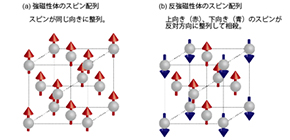
Magnetization process in antiferromagnetic materials observed
A group of researchers from Osaka University and the Japan Synchrotron Radiation Research Institute (JASRI) observed electron spin movement (i.e., magnetism at the atomic level) of antiferromagnetic (AFM) materials under the application of voltage.
AFM materials, which are not attracted to magnets, are used for spintronic devices, such as hard drive read heads, angular speed sensors for automobiles, and magnetic random access memory. AFM spins in these devices are fixed and cannot be manipulated.
It is predicted that spin dynamics in antiferromagnets (AFMs) is 100~1,000 times higher than that in magnetization in ferromagnets, but it was very difficult to manipulate spins in devices. Since each electron spin in AFMs tends to align itself in the direction opposite that of the neighboring electron spin, AFMs do not generate external magnetic flux. Thus, it was difficult to detect its tiny signals and modify spin in these devices.
This group used the magnetoelectric (ME) effect to move AFM spin. Usually, when placed in an applied magnetic field, the spin tends to align with the direction of the applied magnetic field. The ME effect observed in chromium oxides (Cr 2 O 3 ) is the induction of magnetization by an electric field and the induction of electric polarization by a magnetic field. The ME effect in Cr 2 O 3 was found in the middle of the 1950s, but how electron spin moves and its velocity were unknown because it was impossible to detect tiny signals from AFMs.
This group developed a magnetization switching technique for changing AFMs with weak antiferromagnetic anisotropic magnetoresistance (AMR) signals to ferromagnets with strong AMR signals by using exchange magnetic anisotropy (also known as exchange bias).
The group observed the magnetization motion generated in antiferromagnetic Cr 2 O 3 by using scanning X-ray magnetic circular dichroism (XMCD) microscopy at the synchrotron radiation facility SPring-8. As a result, the group clarified that magnetization in Cr 2 O 3 happened by propagation of domain walls and that the domain walls moved (like a vehicle creeps) under the application of an electric field (low voltage). That means that voltage acts like an accelerator of a vehicle.
The researchers achieved domain wall propagation in AFM materials by applying voltage (electric field) instead of electric current conventionally used. Previously, controlling antiferromagnetic spin was difficult, but it has become possible by making good use of voltage (electric fields) and magnetic fields. This technique will lead to the development of high-speed spintronic devices, drastically speeding up conventional magnetic devices.
Figure 1
Figure 2
The article "Observation of the magnetoelectric reversal process of the antiferromagnetic domain” was published in APL Materials at DOI: https://doi.org/ 10.1063/1.5053925 .
Related links

